Commodity Classic Student blogger Margy Fischer, sponsored by Monsanto
 As expected, I had an early start to my first full day at Commodity Classic. I attended a breakfast hosted by FFA regarding their program LifeKnowledge.
As expected, I had an early start to my first full day at Commodity Classic. I attended a breakfast hosted by FFA regarding their program LifeKnowledge.
It was the best way to start a day here – with lots of agricultural products. From the orange juice, to the egg quiche, to the French toast with almonds and peaches, our tables celebrated our diverse food supply.
FFA promoted their exciting initiative of engaging and interactive leadership lessons called LifeKnowledge. The program is sponsored by John Deere, Monsanto, the National Pork Board, Chevrolet, and Cargill.
There were four student leaders of the Hanford FFA chapter, Hanford California present at the breakfast, so they got a day off from school and the chance to boast about the advantages of LifeKnowledge, which their teacher Kris Elliot who uses these lessons in his classrooms. From what I learned this morning, these lessons can be used to integrate leadership lessons into all classrooms, even technical classes.
FFA was not available at my high school, but I was enthused to see what the organization is doing to improve our youth leadership education which can have powerful impacts on our society and the agricultural industry.
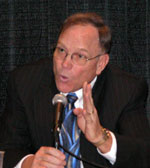 The first press conference here at Commodity Classic is always with the leadership of NCGA and ASA. Next year that will include NAWG, but more on that later. To get us started I interviewed NCGA President, Gerald Tumbleson.
The first press conference here at Commodity Classic is always with the leadership of NCGA and ASA. Next year that will include NAWG, but more on that later. To get us started I interviewed NCGA President, Gerald Tumbleson. Tumbleson Interview (4:05 MP3 File)
Tumbleson Interview (4:05 MP3 File) AgWired coverage of Commodity Classic is being made posssible by our good friends at New Holland.
AgWired coverage of Commodity Classic is being made posssible by our good friends at New Holland.
 As Chuck posted, Mary and I got a sneak peek of the trade show. This year’s show is featuring over 180 companies in over 645 booths. At 3 (Pacific time) the show will officially open to the press, and yes, Mary and I were able to receive press credentials although we are getting some funny looks from people. Maybe they are confused about our blogging…
As Chuck posted, Mary and I got a sneak peek of the trade show. This year’s show is featuring over 180 companies in over 645 booths. At 3 (Pacific time) the show will officially open to the press, and yes, Mary and I were able to receive press credentials although we are getting some funny looks from people. Maybe they are confused about our blogging…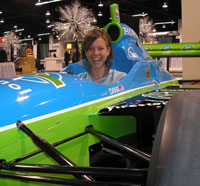 Already, I’ve had a chance to sit in a copy of the ethanol powered Indy car.
Already, I’ve had a chance to sit in a copy of the ethanol powered Indy car.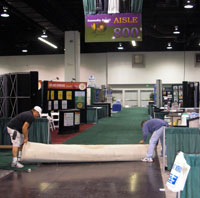 I asked the college bloggers to think creatively and find some pictures to post. Here’s another one Margy came up with. The post title is hers too.
I asked the college bloggers to think creatively and find some pictures to post. Here’s another one Margy came up with. The post title is hers too. Margy took a picture at the NCGA booth because she thought this was such an interesting collection of products made from corn.
Margy took a picture at the NCGA booth because she thought this was such an interesting collection of products made from corn. It is a beautiful Thursday here in Anaheim. We started of the day by going to the National FFA Organization LifeKnowledge breakfast. This was a press conference that allowed the National FFA to announce their LifeKnowledge program that is being implemented into schools across the nation. This had special interest to me because I was a member of the Illinois FFA for five years and this past summer finished up my year of service as the Illinois FFA Section 5 President. LifeKnowledge is basically a program that incorporates leadership into the agriculture classroom. It is not just for FFA members but for everyone in agriculture. Not only that but the program is available for any teacher Ag related or not. It is a great way to teach America’s youth how to be good leaders, not only in the workforce but in their communities as well. LifeKnowledge helps develop the skills needed for the real world that aren’t always available to teach in the classroom until now.
It is a beautiful Thursday here in Anaheim. We started of the day by going to the National FFA Organization LifeKnowledge breakfast. This was a press conference that allowed the National FFA to announce their LifeKnowledge program that is being implemented into schools across the nation. This had special interest to me because I was a member of the Illinois FFA for five years and this past summer finished up my year of service as the Illinois FFA Section 5 President. LifeKnowledge is basically a program that incorporates leadership into the agriculture classroom. It is not just for FFA members but for everyone in agriculture. Not only that but the program is available for any teacher Ag related or not. It is a great way to teach America’s youth how to be good leaders, not only in the workforce but in their communities as well. LifeKnowledge helps develop the skills needed for the real world that aren’t always available to teach in the classroom until now. 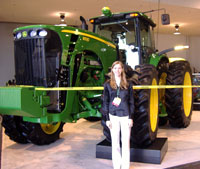 The trade show here at the 2006 Commodity Classic is currently being set up and the booths look amazing. In this picture you see me with a huge John Deere 8530. Yes, I’m a green fan. We also visited the ethanol booth where they had an Indy Racing Car simulator run by the Ethanol Promotion and Information Counsel. Be looking for video clips and pictures of it from either Margy or I in the near future.
The trade show here at the 2006 Commodity Classic is currently being set up and the booths look amazing. In this picture you see me with a huge John Deere 8530. Yes, I’m a green fan. We also visited the ethanol booth where they had an Indy Racing Car simulator run by the Ethanol Promotion and Information Counsel. Be looking for video clips and pictures of it from either Margy or I in the near future. 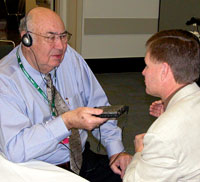 The media are so enthusiastic here at the start of Commodity Classis that they’re even interviewing each other.
The media are so enthusiastic here at the start of Commodity Classis that they’re even interviewing each other.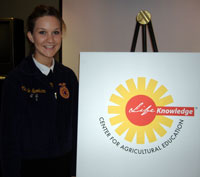 The first assignment I gave to my student bloggers was to cover this morning’s
The first assignment I gave to my student bloggers was to cover this morning’s 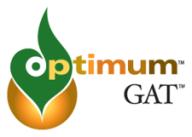 A lot of announcements will be made at Commodity Classic this week, or at least timed for the event. Here’s one we’ve been expecting since last week’s
A lot of announcements will be made at Commodity Classic this week, or at least timed for the event. Here’s one we’ve been expecting since last week’s  The Mickey ears give our location away. This photo was inspired by Tom Steever, Brownfield Network. This was our view from the Bayer CropScience dinner. Great food and company.
The Mickey ears give our location away. This photo was inspired by Tom Steever, Brownfield Network. This was our view from the Bayer CropScience dinner. Great food and company.